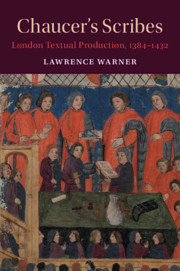Crossref Citations
This Book has been
cited by the following publications. This list is generated based on data provided by Crossref.
Warner, Lawrence
2018.
Chaucer’s Non-Debt to Langland.
The Yearbook of Langland Studies,
Vol. 32,
Issue. ,
p.
353.
Edwards, A. S. G.
2018.
What is Palaeography For?.
The Mediaeval Journal,
Vol. 8,
Issue. 2,
p.
21.
Meyer-Lee, Robert J.
2019.
Literary Value and Social Identity in the Canterbury Tales.
Johnson, Ian
2019.
Geoffrey Chaucer in Context.
Weiskott, Eric
2019.
Political Prophecy and the Form of Piers Plowman.
Viator,
Vol. 50,
Issue. 1,
p.
207.
2020.
The Afterlife of St Cuthbert.
p.
321.
2020.
The ‘Roman de la Rose' and Thirteenth-Century Thought.
p.
323.
Smith, Jeremy J.
2020.
Transforming Early English.
Whitehead, Christiania
2020.
The Afterlife of St Cuthbert.
2020.
30 Great Myths About Chaucer.
p.
189.
Da Rold, Orietta
2020.
Paper in Medieval England.
Simon-Jones, Lindsey
Pitard, Derrick
and
Twu, Krista Sue-Lo
2020.
IV Chaucer.
The Year's Work in English Studies,
Vol. 99,
Issue. 1,
p.
292.
Ash-Irisarri, Kate
Atkinson, Laurie
Black, Daisy
Brazil, Sarah
Calder, Natalie
Finn, Andrew
Greene, Darragh
Grossman, Joel
Lazikani, Ayoush
Menmuir, Rebecca
Pascual, Rafael J
Sargan, J D
and
Wolf, Johannes
2021.
III Middle English.
The Year's Work in English Studies,
Vol. 100,
Issue. 1,
p.
195.
Alcolado Carnicero, José Miguel
2021.
The diffusion of English in late medieval social networks: Henry V, Robert Chicheley, London Grocers, and London Brewers.
Language & History,
Vol. 64,
Issue. 2,
p.
69.
Fein, Susanna
2021.
Writers, Editors and Exemplars in Medieval English Texts.
p.
15.
2021.
Landscape in Middle English Romance.
p.
288.
2022.
A New Literary History of the Long Twelfth Century.
p.
291.
Rikhardsdottir, Sif
2023.
The Chaucer Encyclopedia.
p.
267.
2023.
The Life Course in Old English Poetry.
p.
268.
Johnston, Michael
2023.
Further Remarks on the Audience and Public of Piers Plowman.
The Yearbook of Langland Studies,
Vol. 37,
Issue. ,
p.
11.





